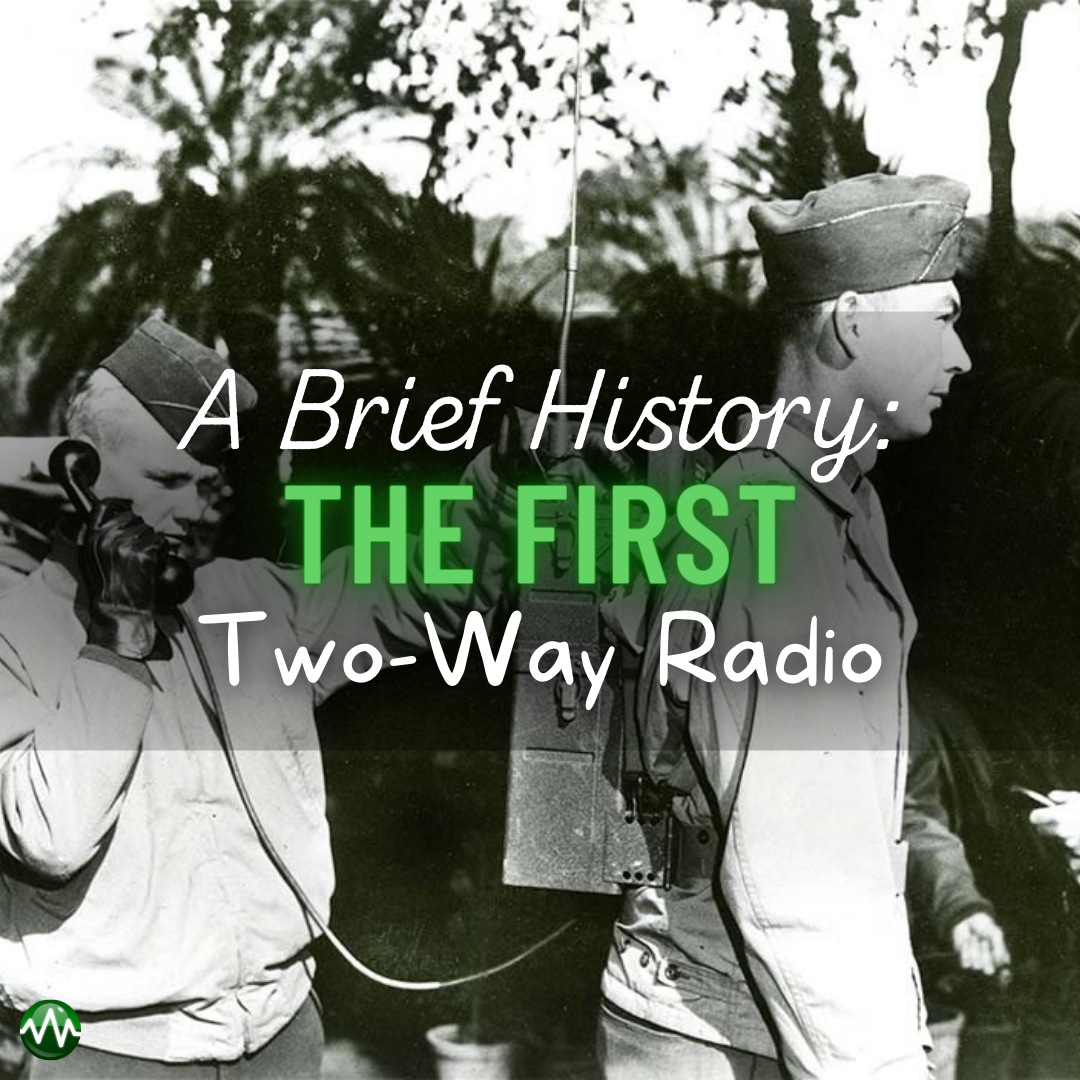
A Brief History on the First Two-Way Radio
Two-way radio has came a long way from the time it was invented to what we know it as today. In fact, the industry hasn't stopped growing. In 2017, the two-way radio industry was estimated to be worth $13.5 billion. This year, it’s worth around $30 billion, and this growth shows no signs of slowing down. As we look toward the exciting future of the two-way radio industry, we can't forget how things things got started. Today we explore the origins of the first two-way radio and investigate who invented the first in existence.
It may not be surprising to hear that there is some controversy surrounding the creation of the first two-way radio. Before we get into that, let's get into who made this possible.
German physicist Henrich Hertz was the first person that was able to prove that energy could be transmitted through electro-magnetic waves around the year 1886. Although, like quite a few other inventors of his time, Hertz thought this knowledge held no practical use. Poor Henrich Hertz didn't know that after his lifetime, this discovery would be celebrated, and eventually, the hertz, the unit of frequency, was named in his honor.

By the year 1891, a form of two-way radio was being used on ships as wireless telegrams improved safety on the seas between ships. The needle continued to be moved forward by Nikola Tesla with the first public demonstration of two-way radio 1893. He also created the Tesla coil that was used in commercially in certain types of radios until the 1920's.

In 1897, a man named Guglielmo Marconi founded The Wireless Telegraph & Signal Company. He began testing and experimenting with radio communication, helping to install radio communication systems on ships to send distress signals and communicate. Although Marconi greatly advanced the radio communication industry, these weren't exactly two-way radio communications.

The year 1907 brought more access to commercial two-way telegraphy that was able to traverse the Atlantic. The use of two-way radios in aviation shortly followed in 1910. By 1912, the use of wireless communication became more well-known, and was starting to be used more widely.
In part, this was due to the wireless radio technology aboard the infamous Titanic. Although various reports differ, the presence of this technology is said to have saved a large number of people aboard the Titanic. The communication system aboard the ship was credited to Marconi, and brought even more attention to this novel form of communication.
1912 also brought the first regulations to radio, and amateurs using radio were now required to get licenses in order to practice.
After WWI started, measures were taken in 1917 to bring an end to communication from all radio stations that were not considered essential due to the war effort.
This suspension provided a path for WWI Officer Edwin Armstrong to make his contributions to radio. Armstrong would be credited with developing the 'Super Heterodyne Receiver', and also is known for the invention of FM radio.

The 1920's would bring some stability to radio communication along with more advancements in the industry. This decade would also bring about the first true two-way radio and give us more than one answer to our question: who invented the first two way radio?
In 1921, William Rutledge, the police commissioner of Detroit became the first public safety figure to use a vehicle equipped with a mobile radio. However, the first true, two-way, mobile radio, was credited to Frederick William Downie, a constable of the Victorian Police in Australia. Downie's development alllowed the department to communicate back and forth for the first time while on the road. Previously, policemen on the force would have to stop every so often to call in for updates, and to relay communication, providing a huge breakthrough for the world's emergency response systems.
 William Rutledge
William Rutledge
The story sounds like it should end there with Constable Downie, however, that's not how this story ends. I did say there may be a couple answers to the question of who invented two-way radio.
The Galvin Manufacturing company was established in 1928 and also played a part in two-way radio. They became a huge developer and manufacturer of radios, and created the SCR-300 radio used in 1943 by the military.

Although Galvin seems to be a little behind on their developments, some do credit them with the first two-way radio. This could be possible, but there are many indications that they came in a little later in the game.
Mobile radio communication pioneer Al Gross is also given credit when it comes to the first two-way radio. Gross was a lifelong radio enthusiast and regularly investigated unexplored radio frequencies. He is credited with patenting one later version of the walkie-talkie, while Donald Lewis Hings created the very first walkie-talkie.

Hings created the very first walkie-talkie in 1937 for his employer CM&S which he called a 'packset'. Hings, a Canadian, developed a number of radios over the years. One of those radios, the C-58, was produced in mass for the Canadian infantry, showing Hings' true radio prowess. Hings developments in two-way radio make him one of the fathers of two-way radio world.

So who is the true inventor of the first two-way radio? Hopefully this blog has given you enough information to think about to help you decide, but there's another answer to this question. Maybe there there are multiple people that created the first two-way radio. Maybe you have your mind made up on someone in particular. Either way, these various advancements and achievements through the history of radio should be celebrated. After all, the hobby and industry we all know and love today would not be possible if these people had not not stepped up and created a wonderful world of radio for us all to live in. Maybe instead of debating who did it first, it's best to give this title to all of these people.
So to Mr. Hertz, Tesla, Marconi, Armstrong, Rutledge, Downie, Galvin, Gross, and Hings, thank you. You paved the way for this two-way radio industry, and gave this this future generation of radio enthusiasts a hobby to love and enjoy.
Sources:
https://www.chicomm.com/blog/evolution-of-two-way-radio-communication
https://comsco.com/blog/a-brief-history-of-the-two-way-radio/
https://kingradios.net/then-and-now-the-history-of-two-way-radio-communication/
https://www.techwholesale.com/two-way-radio-invention.html
https://www.soneticscorp.com/history-of-two-way-wireless/
It may not be surprising to hear that there is some controversy surrounding the creation of the first two-way radio. Before we get into that, let's get into who made this possible.
German physicist Henrich Hertz was the first person that was able to prove that energy could be transmitted through electro-magnetic waves around the year 1886. Although, like quite a few other inventors of his time, Hertz thought this knowledge held no practical use. Poor Henrich Hertz didn't know that after his lifetime, this discovery would be celebrated, and eventually, the hertz, the unit of frequency, was named in his honor.

By the year 1891, a form of two-way radio was being used on ships as wireless telegrams improved safety on the seas between ships. The needle continued to be moved forward by Nikola Tesla with the first public demonstration of two-way radio 1893. He also created the Tesla coil that was used in commercially in certain types of radios until the 1920's.

In 1897, a man named Guglielmo Marconi founded The Wireless Telegraph & Signal Company. He began testing and experimenting with radio communication, helping to install radio communication systems on ships to send distress signals and communicate. Although Marconi greatly advanced the radio communication industry, these weren't exactly two-way radio communications.

The year 1907 brought more access to commercial two-way telegraphy that was able to traverse the Atlantic. The use of two-way radios in aviation shortly followed in 1910. By 1912, the use of wireless communication became more well-known, and was starting to be used more widely.
In part, this was due to the wireless radio technology aboard the infamous Titanic. Although various reports differ, the presence of this technology is said to have saved a large number of people aboard the Titanic. The communication system aboard the ship was credited to Marconi, and brought even more attention to this novel form of communication.
1912 also brought the first regulations to radio, and amateurs using radio were now required to get licenses in order to practice.
After WWI started, measures were taken in 1917 to bring an end to communication from all radio stations that were not considered essential due to the war effort.
This suspension provided a path for WWI Officer Edwin Armstrong to make his contributions to radio. Armstrong would be credited with developing the 'Super Heterodyne Receiver', and also is known for the invention of FM radio.

The 1920's would bring some stability to radio communication along with more advancements in the industry. This decade would also bring about the first true two-way radio and give us more than one answer to our question: who invented the first two way radio?
In 1921, William Rutledge, the police commissioner of Detroit became the first public safety figure to use a vehicle equipped with a mobile radio. However, the first true, two-way, mobile radio, was credited to Frederick William Downie, a constable of the Victorian Police in Australia. Downie's development alllowed the department to communicate back and forth for the first time while on the road. Previously, policemen on the force would have to stop every so often to call in for updates, and to relay communication, providing a huge breakthrough for the world's emergency response systems.

The story sounds like it should end there with Constable Downie, however, that's not how this story ends. I did say there may be a couple answers to the question of who invented two-way radio.
The Galvin Manufacturing company was established in 1928 and also played a part in two-way radio. They became a huge developer and manufacturer of radios, and created the SCR-300 radio used in 1943 by the military.

Although Galvin seems to be a little behind on their developments, some do credit them with the first two-way radio. This could be possible, but there are many indications that they came in a little later in the game.
Mobile radio communication pioneer Al Gross is also given credit when it comes to the first two-way radio. Gross was a lifelong radio enthusiast and regularly investigated unexplored radio frequencies. He is credited with patenting one later version of the walkie-talkie, while Donald Lewis Hings created the very first walkie-talkie.

Hings created the very first walkie-talkie in 1937 for his employer CM&S which he called a 'packset'. Hings, a Canadian, developed a number of radios over the years. One of those radios, the C-58, was produced in mass for the Canadian infantry, showing Hings' true radio prowess. Hings developments in two-way radio make him one of the fathers of two-way radio world.

So who is the true inventor of the first two-way radio? Hopefully this blog has given you enough information to think about to help you decide, but there's another answer to this question. Maybe there there are multiple people that created the first two-way radio. Maybe you have your mind made up on someone in particular. Either way, these various advancements and achievements through the history of radio should be celebrated. After all, the hobby and industry we all know and love today would not be possible if these people had not not stepped up and created a wonderful world of radio for us all to live in. Maybe instead of debating who did it first, it's best to give this title to all of these people.
So to Mr. Hertz, Tesla, Marconi, Armstrong, Rutledge, Downie, Galvin, Gross, and Hings, thank you. You paved the way for this two-way radio industry, and gave this this future generation of radio enthusiasts a hobby to love and enjoy.
Sources:
https://www.chicomm.com/blog/evolution-of-two-way-radio-communication
https://comsco.com/blog/a-brief-history-of-the-two-way-radio/
https://kingradios.net/then-and-now-the-history-of-two-way-radio-communication/
https://www.techwholesale.com/two-way-radio-invention.html
https://www.soneticscorp.com/history-of-two-way-wireless/






